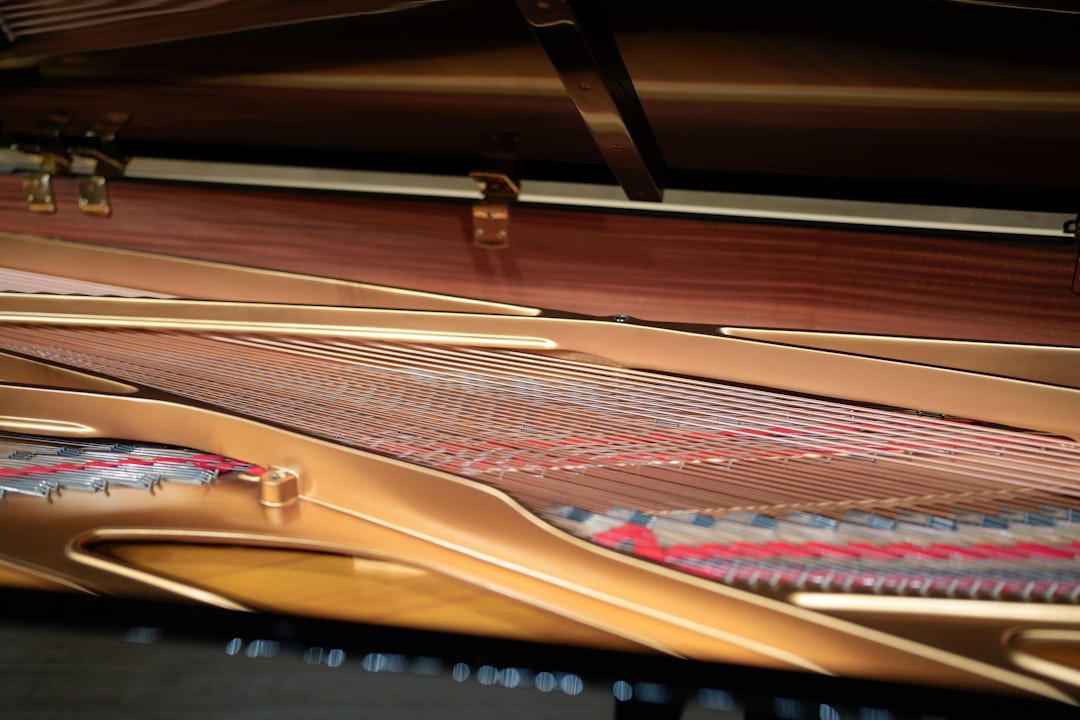

Engage prospects with a scan and streamline customer engagement with FREE QR code marketing tools by Sona – no strings attached!
Create a Free QR CodeFree consultation

No commitment

Engage prospects with a scan and streamline customer engagement with FREE QR code marketing tools by Sona – no strings attached!
Create a Free QR CodeFree consultation

No commitment
Piano repair services are undergoing rapid digital transformation, driven by evolving customer expectations and advancements in marketing technology. Today, piano technicians, repair shops, and restoration specialists face the challenge of connecting traditional offline interactions such as in-home visits, service brochures, or event demonstrations with digital workflows that engage, inform, and convert potential clients. A persistent issue is that high-value prospects exploring services often stay anonymous, leading to missed follow-ups and lost opportunities.
As competition intensifies, standing out now depends on the ability to streamline service discovery, respond quickly to inquiries from those who may not submit a contact form, and drive conversions through every available channel. QR codes offer piano repair services a powerful bridge between the physical and digital experience. With the fragmentation of the customer journey, there is an increased risk of potential leads never making it to your CRM. See how this fits into broader strategies in QR codes in marketing.
By applying unique, data-driven QR strategies, it becomes easy to capture leads during piano inspections, drive post-service reviews, enable instant quote requests, and provide valuable resources like tuning schedules or insurance information, all with a seamless scan. For example, boost social proof with Google Reviews QR codes and capture maintenance preferences or reminders via Google Forms QR. This approach removes friction from the customer journey and helps surface previously unknown interest, while unlocking a wealth of actionable data for targeted follow-ups, retargeting, and retention.

Offline interactions like piano appraisals, tuning visits, or event flyers traditionally lacked an easy way to bring customers online, often resulting in lost high-intent leads who never submit a form. QR codes bridge this gap by turning physical engagements into measurable digital actions. When a tuning visit ends with a friendly goodbye, a QR code gives the client a clear next step, such as booking a restoration consultation or opting into maintenance reminders. The result is more captured demand and fewer missed opportunities.
To make QR codes work, align each placement with a specific behavior you want to trigger. For example, service vans and workshop windows can invite quick inquiries, while invoices can request reviews or offer maintenance discounts. The key is to lead scanners to purpose-built landing pages, not generic homepages, and to track all outcomes from scan to booking. Learn how the platform supports this on the Sona QR product overview.
With smart platforms supporting your QR deployment, missed connections become new leads. You can reduce friction, accelerate response times, and consistently convert offline interest into measurable online outcomes throughout the service funnel. Start creating QR codes for free.

Piano repair services face unique hurdles: fragmented customer journeys, untraceable offline leads, and the need to showcase specialized offerings such as soundboard repair, action regulation, or full restorations. Many prospects research or attend demonstrations without immediately reaching out, which leaves them invisible to your CRM. This invisibility makes it hard to retarget, nurture, and eventually convert high-value prospects who demonstrated interest but never filled out a form.
QR codes solve these issues by making it effortless for clients to take action right when curiosity peaks. Whether a potential client is holding a flyer from a music school, inspecting a piano at a community recital, or interacting with a technician in their living room, a scan provides immediate access to the right information or booking flow. The experience feels natural, fast, and helpful for the customer, and it produces clean data for your business.
By strategically placing QR codes at key moments in the customer journey, you turn analog interest into actionable digital signals. This increases conversion rates, improves follow-through, and helps piano repair brands build a reliable pipeline from everyday interactions.

Choosing the right QR format ensures each scan triggers the ideal action and captures the data you need. Piano repair scenarios often involve high-context decisions, so your destinations must be specific to the intent of each placement. For example, a code on an appraisal flyer should lead to an appraisal-specific intake form, not a general contact page.
Dynamic QR codes are recommended for most marketing uses because they allow you to edit destinations, add UTM parameters, and view analytics without replacing printed materials. Static QR codes work for permanent resources, such as a workshop Wi-Fi login or a PDF care guide, but they limit your ability to optimize after deployment.
For most piano repair marketing initiatives, dynamic web link codes and SMS or email pre-fill codes deliver the strongest balance of conversion and data. Use vCards on business cards and technician badges to make contact capture effortless.

QR codes deliver outsized impact when placed where clients are primed to act. Many piano repair businesses rely on flyers, cards, and word of mouth, yet without a direct link to a digital action those impressions decay quickly. You can reverse that pattern by connecting common materials to specific digital outcomes and tracking the results. For ideas on outreach, this forum thread shares practical piano advertising tips.
Think about where clients physically encounter your brand or technicians and what the most likely next step should be. If someone is sitting in a workshop lobby, they may be open to leaving a review or browsing restoration packages. If a parent grabs a flyer at a music school, they may be a good fit for a seasonal tuning package or a first-time evaluation.
Optimizing placement around customer behavior not only increases the volume of scans but also improves conversion quality. Over time, you will learn which materials and locations consistently surface high-intent prospects, then scale those wins across your market.
QR codes turn the most important piano repair moments into measurable, repeatable growth. Instead of hoping a client will remember to call later, you offer a simple scan that performs the next best action in seconds. The use cases below map directly to common interactions and business goals.
Together, these use cases reduce friction, capture data that feeds your CRM, and help you deliver the right follow-up at the right time. By focusing on high-intent contexts like in-home visits and post-service touchpoints, you can lift conversion rates and retention consistently.
Every scan is a data point that reveals intent and context. By deploying different codes across your materials and locations, you can automatically segment audiences based on what they scanned, where they scanned it, and when. This allows you to nurture clients with highly relevant content and offers rather than generic follow-ups.
The practical payoff is better ad targeting, stronger email engagement, and more effective sales outreach. By syncing scans into your CRM, you can build lifecycle journeys that reflect real behavior and timing, such as sending a reminder when a tuning is due or promoting restoration when someone has viewed a case study. For stronger execution, get quick sales tips.
With Sona QR, each code doubles as a smart audience tag. You can automatically build lists and trigger workflows based on scan behavior, making your retargeting precise, timely, and cost-effective.
Your marketing already spans multiple channels, from print to events to social. The challenge is that print materials and in-person conversations rarely feed clean data into your analytics and CRM. QR codes change that by turning every channel into a measurable onramp that enriches your understanding of the customer journey.
When each channel drives a consistent next step and logs the result, your team can see which efforts truly impact bookings and revenue. This connected view enables smarter budget allocation and faster iteration across campaigns.
With a centralized platform like Sona QR, you can manage all codes, track performance by channel, and sync scan data with your CRM and ad platforms. This makes every channel more accountable and every campaign easier to optimize.
A structured approach prevents wasted print runs, unscannable placements, and unmeasured results. Think of this checklist as a repeatable framework you can apply to each new campaign, whether it is focused on tune-ups, restoration, or appraisals. The steps below guide you from planning to optimization and ensure that your physical assets are tied to measurable outcomes.
Use this playbook with your team so technicians, marketers, and operations align on goals, placements, and follow-up workflows. When everyone understands both the purpose of each code and how results will be tracked, you reduce friction and speed up learning cycles.
Clarify what you want the scan to accomplish. Examples include booking a tuning, requesting a restoration quote, leaving a review, or signing up for seasonal reminders. One use case per code keeps your message focused and your landing page tailored to the intent.
Decide between static and dynamic codes. For most marketing placements, choose dynamic codes to enable tracking, editing, and retargeting without reprinting. Static codes work for resources that will never change, such as a permanent Wi-Fi login.
Design for speed and clarity. Place a clear call to action next to your code such as “Scan to book tuning” or “Scan for a restoration estimate.” Brand the code frame with your logo and colors to build trust and recognition.
Roll out your codes where the intended audience already interacts with your brand. Prioritize placements that coincide with strong intent, such as technician visits, event demos, or moments when a client is reading an invoice.
Monitor scan and conversion metrics from day one. Review performance by placement, message, and creative. Iterate by adjusting offers, moving underperforming codes, and testing alternate CTAs.
By following these steps, you ensure that each code has a clear purpose, is easy to scan, and is tied to an outcome you can measure. Over time, this disciplined execution turns QR into a reliable engine for bookings and customer growth.
Attribution is a persistent challenge in piano repair marketing. Without proper tracking, it is difficult to know whether a flyer, a demonstration, or a technician visit drove an actual booking. QR codes, combined with a robust analytics layer, close this gap by linking offline interactions to measurable digital events and revenue outcomes.
Modern QR platforms such as Sona QR allow you to view scan volume, location, device type, and campaign source, then connect those scans to downstream actions like form fills, bookings, reviews, or repeat service requests. This gives you a clear picture of which channels and assets generate the best returns.
Sona.com adds identity resolution and multi-touch attribution on top of Sona QR, making it possible to see how scans interact with other marketing activities. For deeper context, explore Sona’s blog on account identification and multi-touch attribution.
As you build momentum, a few best practices will help you scale without losing quality. The goals are consistent scannability, clear messaging, and automated follow-up that converts interest into action. Educate your team on why QR codes matter and how to present them in a way that feels natural during service interactions.
Consider implementing automation that triggers thank-you messages, reminders, or offers when a scan occurs. These timely touches reinforce your brand and move customers closer to booking or repeat service.
For creative deployment, try a QR code on a tuning certificate that schedules the next visit in six months, or a code on an invoice that unlocks a loyalty discount for future services. These touches turn one-time interactions into ongoing relationships.
Effective execution requires aligning strategy with day-to-day operations. Start by defining one clear objective per campaign, then select formats and placements that make achieving that objective as simple as possible for the customer. Tie every scan to a landing page that delivers immediate value, and ensure your team can respond rapidly to new leads or bookings.
As your campaigns run, treat them like a living system. Review performance weekly, fix bottlenecks quickly, and lean into the messaging and placements that outperform. This cycle of testing and iteration compounds your results over time.
By following these steps, you can turn offline activity into a predictable flow of digital engagement and revenue. The discipline of clear objectives, smart placements, and continuous optimization is what transforms QR from a tactic into a strategy.

Creativity matters because it increases the likelihood of a scan and elevates the customer experience. The best QR deployments meet customers where they are, remove steps, and make the next action obvious. Below are examples inspired by real piano repair workflows that show how to blend utility with measurement.
Use these ideas as a starting point, then adapt them to your brand voice, service mix, and local market. The goal is not just to get scans, but to create a smooth journey from offline engagement to online conversion.
These examples show how QR codes surface engagement signals wherever they occur and turn those signals into actions you can measure. Small, thoughtful deployments can produce significant improvements in bookings and retention.
Even well-planned QR campaigns can stumble if scanning is unreliable, destinations are generic, or staff do not explain the value. The difference between average and exceptional results often comes down to execution details and training. Make scannability flawless, keep messages specific, and ensure your team introduces the code naturally during service delivery.
A common pitfall is treating QR codes as mere links rather than behavior triggers. Each placement should have a single, clear purpose, and the landing page should make that action easy. Avoid sending scanners to your homepage or a cluttered menu that forces them to hunt for what was promised.
QR codes are more than a shortcut, they are a strategic tool for piano repair services striving to prevent missed opportunities, enhance customer visibility, and modernize the complete service journey. By embedding QR codes on flyers, service receipts, workshop signage, and event materials, piano repair businesses can identify previously anonymous prospects, streamline appointment scheduling, and gather rich engagement data that turns each client interaction into an actionable sales asset. This holistic approach addresses the pain of fragmented lead tracking and provides the clear attribution and targeted follow-up needed for real growth.
With QR-powered insight, piano repair professionals gain the ability to monitor what drives service bookings and reviews, tailor outreach based on true customer interest, and activate highly relevant remarketing across all channels. Every scan now becomes a quantifiable touchpoint in the journey from casual inquiry to loyal, recurring customer, providing the control and agility necessary for sustainable business expansion in a competitive marketplace.
QR codes have transformed piano repair services from simple appointment scheduling tools into dynamic, measurable customer engagement channels. Whether it’s driving new client acquisition, enhancing service transparency, or providing instant access to maintenance tips and promotions, QR codes replace traditional, static outreach with real-time, mobile-friendly interactions that capture valuable customer data and boost conversions.
Imagine knowing exactly which repair guides or special offers inspire customers to book your services—and updating those campaigns instantly without reprinting. With Sona QR, you can create dynamic, trackable QR codes in seconds, connect every scan directly to your revenue, and gain insights that turn casual inquiries into loyal clients. No wasted effort, no missed opportunities—just smarter, more profitable piano repair marketing.
Start for free with Sona QR today and turn every scan into a tuned-up customer relationship and a thriving business.
Use QR codes on flyers, business cards, or event signage to connect with local piano repair services and easily access booking calendars or request forms for reliable service.
Signs include issues requiring soundboard repair, action regulation, tuning inconsistencies, or the need for full restoration, which can be identified during appraisals or technician inspections.
Costs vary by service type, but you can request instant quotes via QR codes that allow clients to upload photos or videos for accurate estimates during in-home visits.
Regular tuning and maintenance extend the instrument's lifespan, improve sound quality, and help prevent costly repairs, with reminders and care guides accessible through QR codes.
Integrate QR codes across print materials, event booths, service vans, and digital channels to capture leads, request reviews, enable instant bookings, and track customer engagement for targeted follow-ups.
Use Sona QR's trackable codes to improve customer acquisition and engagement today.
Create Your FREE Trackable QR Code in SecondsJoin results-focused teams combining Sona Platform automation with advanced Google Ads strategies to scale lead generation

Connect your existing CRM

Free Account Enrichment

No setup fees
No commitment required

Free consultation

Get a custom Google Ads roadmap for your business






Launch campaigns that generate qualified leads in 30 days or less.
